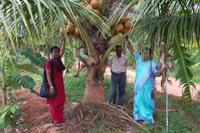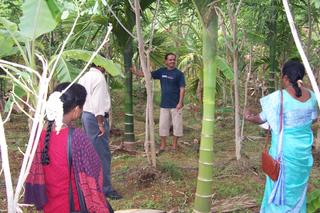in the beginning...
Nilgiri to nisarga...
It all began with the intense heat of a typical Indian summer. In May 2004 the daytime temperatures were touching 37-380C and people in Bangalore wondered what happened to this garden city. The chopping of trees in this ever expanding city was the most visible cause for the heat. But a little more enlightened lot knew this is just a consequence of the global warming that was happening across the world.
Meanwhile just before May Day, I was wondering were shall we go for an outing… just then I read about an organic farmer totally transforming not only his land, but also the entire village. Since I am an organic enthusiast, I was thrilled to know that his place was just outside Nelamangala on Pune-Bangalore highway.
http://www.deccanherald.com/deccanherald/apr202004/spt5.asp
The travel on the highway was agonizing with all the trucks and buses spewing thick smoke. As we turned from the highway on Kunigal Road, we were surprised to find a well-metalled road leading us deep inside the valley way upto Marasarahalli on the edge of Kumudvathi river.
All through the way, there were cultivated farmland and also the ubiquitous Nilgiri plantations. These eucalyptus plantations are the trademark of lazy farmers who grow these fast growing timber without any input. Once these plants suck all the nutrients and moisture from the topsoil, the land becomes degraded. Another startling fact is that the eucalyptus leaves are so loaded with oil that they never decay. So obviously there will be no moisture despite all the shade.
----------------------
To imagine this degraded terrain being transformed into a fertile land, it is a miracle. H R Jayaram who is actually a lawyer by profession has taken all the pain for six years to make this miracle happen. When he bought this land, it was covered with a dense layer of eucalyptus plantations. He had to uproot each one of them, since they can easily sprout back with the help of their strong roots. Work started in 1999 with the drilling of two borewells, one at each corner of the land.
Jayaram made sure to plant more trees from different species so that they complement each other rather than compete on resources. Today after six years of hardwork, this flourishing plot of land is a dense forest of arecanut, banana, coconut, drumstick, Singapore cherry, glyricidia, silver oak, Cyprus, teak, gooseberry, sapota and even vanilla.
Farm veterans have been surprised by a lush greenhouse full of flower plants grown without a trace of fertilizer or pesticide. Everyday a bunch of flowers leave jayaram’s farm for the market place. Yeah, it is surely a meager yield, but when compared to the input, the economics work out very well. 20 labourers worked during the peak days, but now very few of them work since there is little need for maintenance. This coconut palm has given fruit in just three years, standing as evidence for the soil enrichment due to organic activity.
After the successfully nurturing this model plot of land, Jayaram has now fully immersed himself into building a community of self-reliant eco-conscious farmers. He is now part of the core committee of ‘Sahaja Samruddha’ organic farming association. Based in Bangalore city, this forum holds regular meetings with resource persons to enrish the knowledge of its members. Recently it has published a hand guide on ‘10 steps to organic farming’. In an effort to build a holistic organic movement, it encourages farmers to do irrigation using solar or wind power rather than use KEB power supply.
Jayaram has been relentlessly persuading other farmers around the Marasarahalli village to take up organic farming. His model of water seepage concept with thehelp of a check dam, has been an eye-opener for them. Neo-literate farmers Chandrahasaiah and Gangaiah were quite skeptic about these ideas; but as the model farm bloomed, while the other farmlands withered in the summer heat, villagers realized the value of rain-water harvesting.
Earlier weeds were simply burnt, but now farmers have learnt to put them in compost pits and for mulching. They now use areacanut leaves to cover up the base of the plants. Each plot of land has a pond whose water will be useful throughout the summer.



0 Comments:
Post a Comment
<< Home